Spatial–Temporal Characteristics and Influencing Factors of Coupled Coordination between Urbanization and Eco-Environment: A Case Study of 13 Urban Agglomerations in China
Abstract
1. Introduction
2. Literature Review
3. Materials and Methods
3.1. Study Area
3.2. Data Sources
3.3. Variable Coefficient
3.4. Coupled Coordination Model
3.5. Geographical Detector
3.6. Construction of Index System
4. Results
4.1. Time Evolution Characteristics of the Coupled Coordination between Urbanization and Eco-Environment in China’s Urban Agglomerations
4.1.1. Urbanization Index
4.1.2. Eco-Environmental Index
4.1.3. Coupled Coordination Degree
4.2. Spatial Pattern of the Coupled Coordination between Urbanization and Eco-Environment in China’s Urban Agglomerations
4.2.1. Urbanization Index
4.2.2. Eco-Environmental Index
4.2.3. Coupled Coordination Degree
5. Discussion
6. Conclusions
Author Contributions
Funding
Conflicts of Interest
References
- Zhou, Y.X. Urban Geography; The Commercial Press: Beijing, China, 1995. [Google Scholar]
- Gu, C.L. Enlightenment from the main experience of urbanization abroad. City 2010, 10, 6–8. [Google Scholar]
- The World Bank. Available online: https://www.worldbank.org/en/topic/urbandevelopment/overview (accessed on 20 April 2020).
- United Nations. Available online: https://population.un.org/wup/Download/ (accessed on 14 January 2018).
- United Nations. Available online: https://www.un.org/en/climatechange/cities-pollution.shtml (accessed on 9 December 2014).
- Seto, K.C.; Güneralp, B.; Hutyra, L.R. Global forecasts of urban expansion to 2030 and direct impacts on biodiversity and carbon pools. Proc. Natl. Acad. Sci. USA 2012, 109, 16083–16088. [Google Scholar] [CrossRef] [PubMed]
- Fang, C.L.; Bao, C.; Qiao, B. Urbanization Process and Urban Eco-environment Effect; Science Press: Beijing, China, 2008. [Google Scholar]
- Huang, J.C.; Fang, C.L. Analysis of coupling mechanism and rules between urbanization and eco-environment. Geogr. Res. 2003, 22, 211–220. [Google Scholar]
- Renmin Website. Available online: http://en.people.cn/200505/12/eng20050512_184776.html (accessed on 12 May 2005).
- National Development and Reform Commission; Ministry of Housing and Urban-Rural Development. The National New Urbanization Plan (2014–2020); National Development and Reform Commission & Ministry of Housing and Urban-Rural Development: Beijing, China, 2014. [Google Scholar]
- Huang, J.C.; Lin, H.X. Spatial evolution analysis and multi-scenarios simulation of Beijing-Tianjin-Hebei Urban Agglomeration. Geogr. Res. 2015, 25, 1003–1024. [Google Scholar]
- Howard, E. Garden Cities of To-morrow; Routledge: London, UK, 2013. [Google Scholar]
- Carson, R. Silent Spring; Houghton Mifflin Harcourt: Boston, MA, USA, 2002. [Google Scholar]
- Register, R. Ecocities: Rebuilding Cities in Balance with Nature; New Society Publishers: New York, NY, USA, 2006. [Google Scholar]
- Grossman, G.M.; Krueger, A.B. Economic growth and the environment. Q. J. Econ. 1995, 110, 353–377. [Google Scholar] [CrossRef]
- Fang, C.L.; Zhou, C.H.; Guo, C.L.; Chen, L.D.; Li, S.C. Theoretical analysis of interactive coupled effects between urbanization and eco-environment in mega-urban agglomerations. J. Geogr. Sci. 2016, 71, 531–550. [Google Scholar] [CrossRef]
- Cai, D.L.; Fraedrich, K.; Guan, Y.N.; Guo, S.; Zhang, C.Y. Urbanization and the thermal environment of Chinese and US-American cities. Sci. Total Environ. 2017, 589, 200–211. [Google Scholar] [CrossRef] [PubMed]
- Schneider, A.; Friedl, M.A.; Potere, D. Mapping global urban areas using MODIS 500-m data: New methods and datasets based on ‘urban ecoregions’. Remote Sens. Environ. 2010, 114, 1733–1746. [Google Scholar] [CrossRef]
- McClintock, N. Cultivating (a) sustainability capital: Urban agriculture, ecogentrification, and the uneven valorization of social reproduction. Ann. Am. Ass. Geogr. 2018, 108, 579–590. [Google Scholar] [CrossRef]
- Singh, P.; Kikon, N.; Verma, P. Impact of land use change and urbanization on urban heat island in Lucknow city, Central India, a remote sensing-based estimate. Sust. Cities Soc. 2017, 32, 100–114. [Google Scholar] [CrossRef]
- Kong, L.Q.; Tian, G.J.; Ma, B.R.; Liu, X.J. Embedding ecological sensitivity analysis and new satellite town construction in an agent-based model to simulate urban expansion in the Beijing metropolitan region, China. Ecol. Indic. 2017, 82, 233–249. [Google Scholar] [CrossRef]
- Lu, C.Y.; Wei, H.Y.; Bai, J.Y. Response research of eco-environment stress and urbanization based on BP artificial neural network: Yan’an. J. Arid Land Resour. Environ. 2012, 26, 61–66. [Google Scholar]
- Gao, X.C.; Yang, F. The coupling coordination development between urbanization and ecological environment in northwest China. Urban Probl. 2016, 12, 26–33. [Google Scholar]
- Ariken, M.; Zhang, F.; Liu, K.; Fang, C.; Kung, H.T. Coupling coordination analysis of urbanization and eco-environment in Yanqi Basin based on multi-source remote sensing data. Ecol. Indic. 2020, 114, 106331. [Google Scholar] [CrossRef]
- Ren, M.; Cheng, Y.; Ren, J.L. Identification of non-coordination between urbanization and ecological environment in Shandong province. World Reg. Stud. 2016, 25, 58–68. [Google Scholar]
- Srinivasan, V.; Seto, K.C.; Emerson, R.; Gorelick, S.M. The impact of urbanization on water vulnerability: A coupled human-environment system approach for Chennai, India. Glob. Environ. Chang. 2013, 23, 229–239. [Google Scholar] [CrossRef]
- Huang, Y.; Qiu, Q.Q.; Sheng, Y.H.; Min, X.Q.; Cao, Y.W. Exploring the relationship between urbanization and the eco-environment: A case study of Beijing. Sustainability 2019, 11, 6298. [Google Scholar] [CrossRef]
- Lin, X.Q.; Lu, C.Y.; Song, K.S.; Su, Y.; Lei, Y.F.; Zhong, L.X.; Gao, Y.B. Analysis of coupling coordination variance between urbanization quality and eco-environment pressure: A case study of the West Taiwan Strait Urban Agglomeration, China. Sustainability 2020, 12, 2643. [Google Scholar] [CrossRef]
- Liang, L.W.; Wang, Z.B.; Fang, C.L.; Sun, Z. Spatiotemporal differentiation and coordinated development pattern of urbanization and the ecological environment of the Beijing-Tianjin-Hebei urban agglomeration. Acta Ecol. Sin. 2019, 39, 1212–1225. [Google Scholar]
- Zhao, Y.B.; Wang, S.J.; Zhou, C.S. Understanding the relation between urbanization and the eco-environment in China’s Yangtze River Delta using an improved EKC model and coupling analysis. Sci. Total Environ. 2016, 571, 862–875. [Google Scholar] [CrossRef]
- Zeng, H.; Yan, C.H.; Huang, W.B.; Lin, Q.Y.; Yu, L.Y.; Qiu, G.Y. A Case Study on the relationship between urbanization level and water use efficiency in the Pearl River Delta Urban Agglomeration. Acta Sci. Nat. Univ. Pek. 2020, 56, 561–570. [Google Scholar]
- Lewis, W.A. Economic Development with Unlimited Supplies of Labour. Manch. Sch. 1954, 22, 139–191. Available online: https://onlinelibrary.wiley.com/doi/10.1111/j.1467-9957.1954.tb00021.x (accessed on 1 May 1954).
- Cao, S.; Yu, N.; Wu, Y.; Wang, Z.; Mi, J. The educational level of rural labor, population urbanization, and sustainable economic growth in China. Sustainability 2020, 12, 4860. [Google Scholar] [CrossRef]
- Kuznets, S. Economic growth and income inequality. Am. Econ. Rev. 1995, 45, 1–28. [Google Scholar]
- Guo, Y.; Zhao, Y.Q. Review on the relationship between urbanization evolution and economic growth. Econ. Perspect. 2009, 1, 109–114. [Google Scholar]
- Li, T.L.; Li, C.G. Response and feedback urbanization to the development of industrial strcture. Urban Probl. 2003, 5, 50–55. [Google Scholar]
- Dewick, P.; Green, K.; Fleetwood, T.; Miozzo, M. Modelling creative destruction: Technological diffusion and industrial structure change to 2050. Technol. Forecast. Soc. Chang. 2006, 73, 1084–1106. [Google Scholar] [CrossRef]
- Ades, A.F.; Glaeser, E.L. Trade and circuses: Explaining urban giants. Q. J. Econ. 1995, 110, 195–227. [Google Scholar] [CrossRef]
- Ye, Y.M. System obstacles and improvement to urbanization in China. J. Renmin Univ. China 2001, 5, 32–38. [Google Scholar]
- National Development and Reform Commission; Ministry of Housing and Urban-Rural Development. The Development Plan for Yangtze River Delta Urban Agglomeration; National Development and Reform Commission & Ministry of Housing and Urban-Rural Development: Beijing, China, 2016. [Google Scholar]
- National Development and Reform Commission; Ministry of Housing and Urban-Rural Development. The Development Plan for the middle reaches of the Yangtze River Urban Agglomerations; National Development and Reform Commission & Ministry of Housing and Urban-Rural Development: Beijing, China, 2015. [Google Scholar]
- National Development and Reform Commission; Ministry of Housing and Urban-Rural Development. The Development Plan for Chengdu-Chongqing Urban Agglomerations; National Development and Reform Commission & Ministry of Housing and Urban-Rural Development: Beijing, China, 2016. [Google Scholar]
- National Development and Reform Commission; Ministry of Housing and Urban-Rural Development. The Development Plan for Harbin-Changchun Urban Agglomerations; National Development and Reform Commission & Ministry of Housing and Urban-Rural Development: Beijing, China, 2016. [Google Scholar]
- Yao, S.M.; Zhou, C.S.; Wang, D.; Xiu, C.L.; Wang, C.X.; Chen, M.X. New Perspectives on Urban Agglomerations in China; Science Press: Beijing, China, 2016. [Google Scholar]
- National Development and Reform Commission; Ministry of Housing and Urban-Rural Development. The Development Plan for Central Plain Urban Agglomeration; National Development and Reform Commission & Ministry of Housing and Urban-Rural Development: Beijing, China, 2016. [Google Scholar]
- National Development and Reform Commission; Ministry of Housing and Urban-Rural Development. The Development Plan for City Agglomerations in the Guanzhong Plain; National Development and Reform Commission & Ministry of Housing and Urban-Rural Development: Beijing, China, 2018. [Google Scholar]
- National Development and Reform Commission; Ministry of Housing and Urban-Rural Development. The Development Plan for Beibu Gulf Urban Agglomeration; National Development and Reform Commission & Ministry of Housing and Urban-Rural Development: Beijing, China, 2017. [Google Scholar]
- National Development and Reform Commission; Ministry of Housing and Urban-Rural Development. The Development Plan for the Hohhot-Baotou-Ordos-Yulin Urban Agglomeration; National Development and Reform Commission & Ministry of Housing and Urban-Rural Development: Beijing, China, 2018. [Google Scholar]
- Urban Social and Economic Investigation Department of National Bureau of Statistics. China City Statistical Yearbook 2006; China Statistics Press: Beijing, China, 2007. [Google Scholar]
- Urban Social and Economic Investigation Department of National Bureau of Statistics. China City Statistical Yearbook 2011; China Statistics Press: Beijing, China, 2011. [Google Scholar]
- Urban Social and Economic Investigation Department of National Bureau of Statistics. China City Statistical Yearbook 2016; China Statistics Press: Beijing, China, 2016. [Google Scholar]
- Urban Social and Economic Investigation Department of National Bureau of Statistics. China City Statistical Yearbook 2018; China Statistics Press: Beijing, China, 2019. [Google Scholar]
- Ministry of Housing and Urban-Rural Development of the People’s Republic of China. China Urban-Rural Construction Statistical Yearbook 2005; China Statistics Press: Beijing, China, 2006. [Google Scholar]
- Ministry of Housing and Urban-Rural Development of the People’s Republic of China. China Urban-Rural Construction Statistical Yearbook 2010; China Statistics Press: Beijing, China, 2011. [Google Scholar]
- Ministry of Housing and Urban-Rural Development of the People’s Republic of China. China Urban-Rural Construction Statistical Yearbook 2015; China Statistics Press: Beijing, China, 2016. [Google Scholar]
- Ministry of Housing and Urban-Rural Development of the People’s Republic of China. China Urban-Rural Construction Statistical Yearbook 2017; China Statistics Press: Beijing, China, 2018. [Google Scholar]
- Library Society of China. China Library Yearbook 2005; Modern Press Co., Ltd.: Beijing, China, 2006. [Google Scholar]
- Library Society of China; National Library of China. China Library Yearbook 2010; National Library of China Publishing House: Beijing, China, 2010. [Google Scholar]
- Library Society of China; National Library of China. China Library Yearbook 2015; National Library of China Publishing House: Beijing, China, 2016. [Google Scholar]
- Library Society of China; National Library of China. China Library Yearbook 2017; National Library of China Publishing House: Beijing, China, 2018. [Google Scholar]
- Li, Y.L.; Hu, M.; Ma, Y.F. Analysis on coupling degree of coordination between flow of inbound tourism in Xinjiang and regional economic. Resour. Dev. Mark. 2013, 29, 418–421. [Google Scholar]
- Wang, J.F.; Zhang, T.L.; Fu, B.J. A measure of spatial stratified heterogeneity. Ecol. Indic. 2016, 67, 250–256. [Google Scholar] [CrossRef]
- Wang, J.F.; Xu, C.D. Geodetector: Principle and prospective. J. Geogr. Sci. 2017, 72, 116–134. [Google Scholar]
- Ma, Y.M.; Wu, Y.M.; Wu, B.J. Comprehensive evaluation of sustainable urban development of Yangtze river delta based on entropy method and quadrant method. Econ. Geogr. 2015, 35, 47–53. [Google Scholar]
- Chen, M.X.; Lu, D.D.; Zhang, H. Comprehensive evaluation and the driving factors of China’s urbanization. J. Geogr. Sci. 2009, 64, 387–398. [Google Scholar]
- Zhu, J.W.; Xie, X.T.; Li, X.H. A solution to the problem of ecological environmental carrying capacity evaluation: A case study of Henan province. Acta Ecol. Sin. 2017, 37, 7039–7047. [Google Scholar]
- Yu, Y.; Zhao, W.; Martinez-Murillo, J.F.; Pereira, P. Loess Plateau, from degradation to restoration. Sci. Total. Environ. 2020, 738, 140206. [Google Scholar] [CrossRef]
- Peng, J.; Wu, J.S.; Pan, Y.J.; Han, Y.N. Evaluation for regional ecological sustainability based on PSR model: Conceptual framework. Prog. Geogr. 2012, 31, 933–940. [Google Scholar]
- Ren, Y.W.; Cao, W.D.; Zhang, Y.; Su, H.F.; Wang, X.W. Temporal and spatial coupling characteristics of urbanization and ecological environment of three major urban agglomerations in the Yangtze river economic belt. Resour. Environ. Yangtze Basin. 2019, 28, 2586–2600. [Google Scholar]
- Cui, M.H. The relationship of coupling coordination between urbanization and ecological environment: A case of urban cluster in the central plains. Econ. Geogr. 2015, 35, 72–78. [Google Scholar]
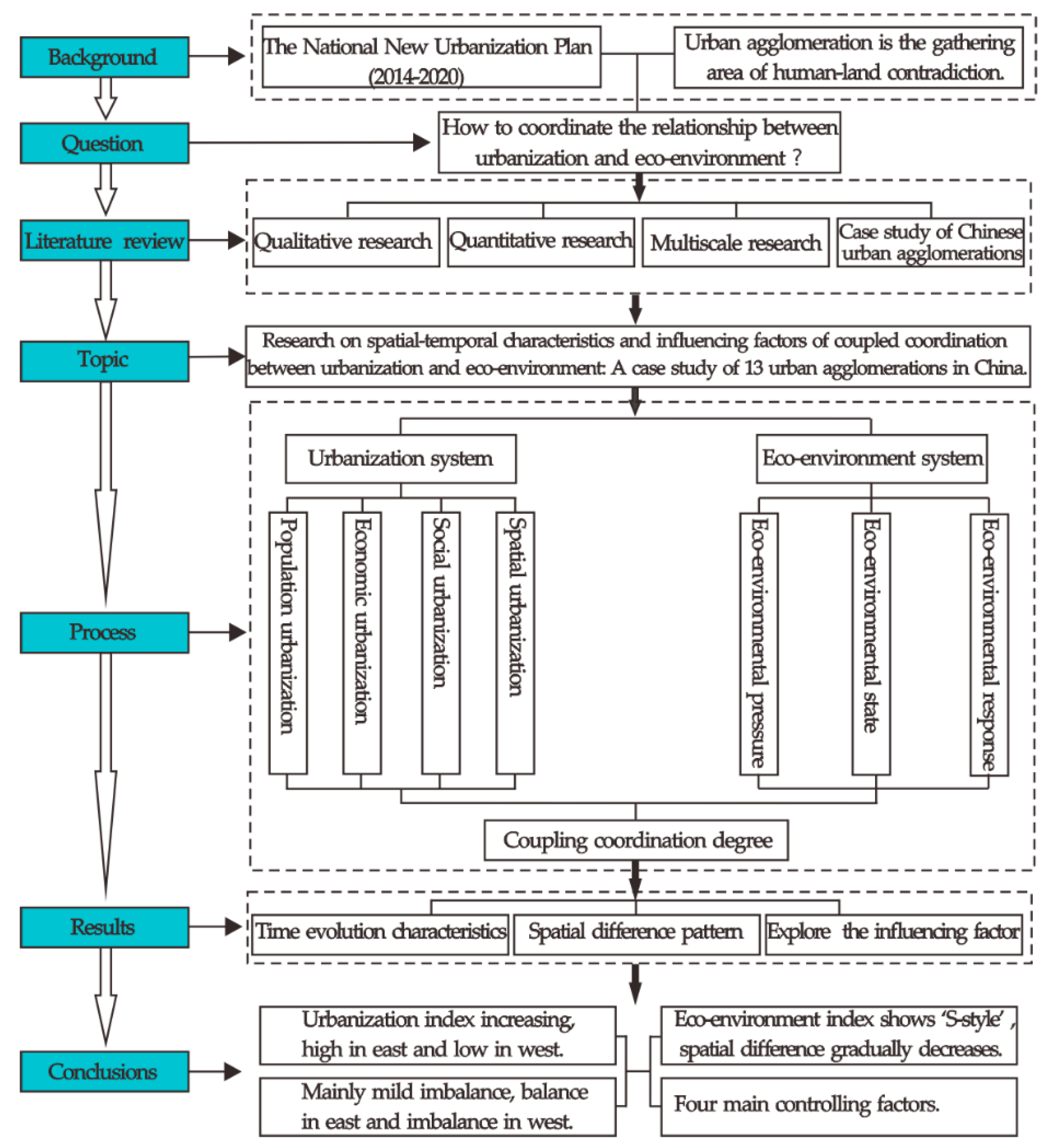
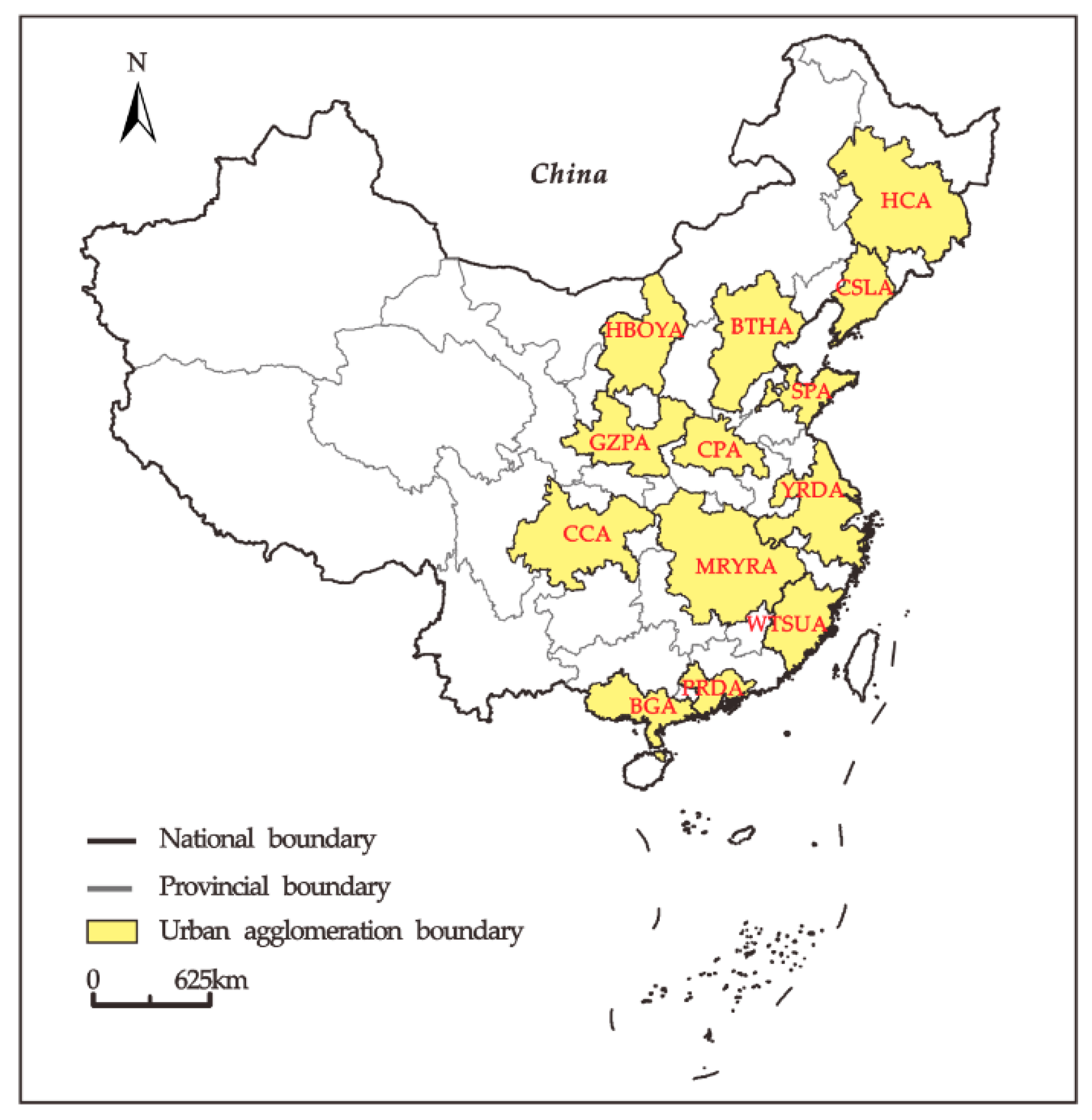
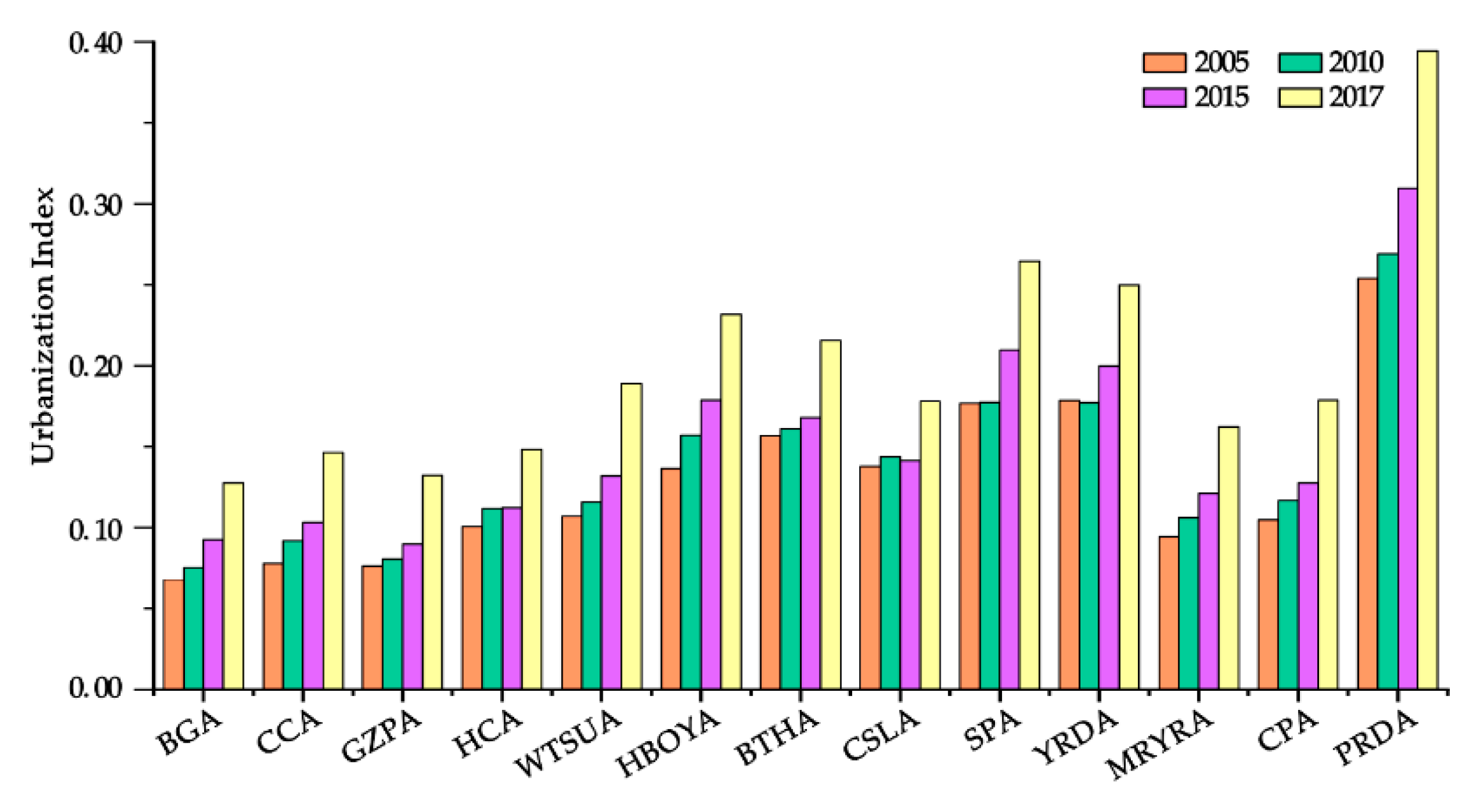
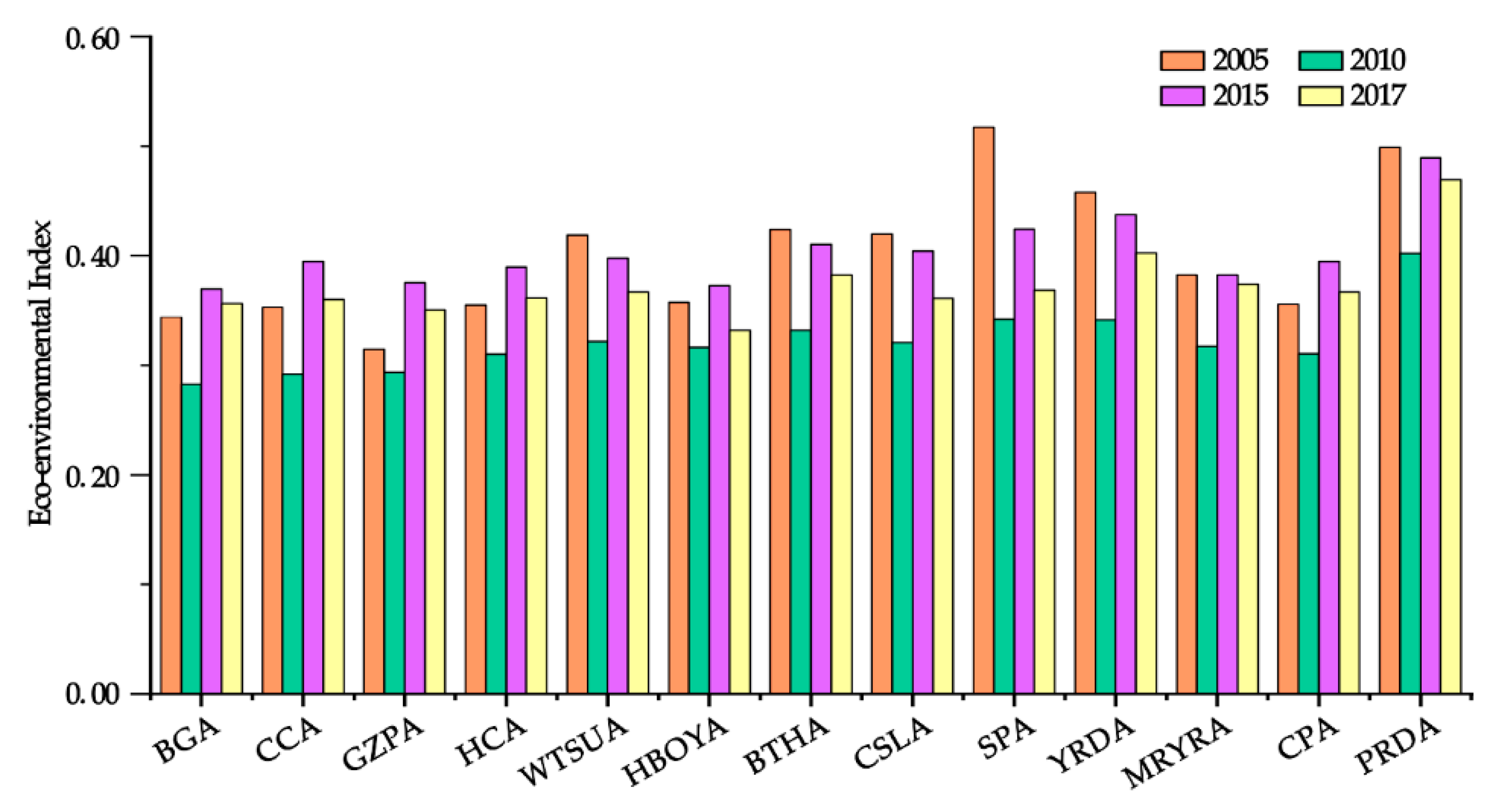
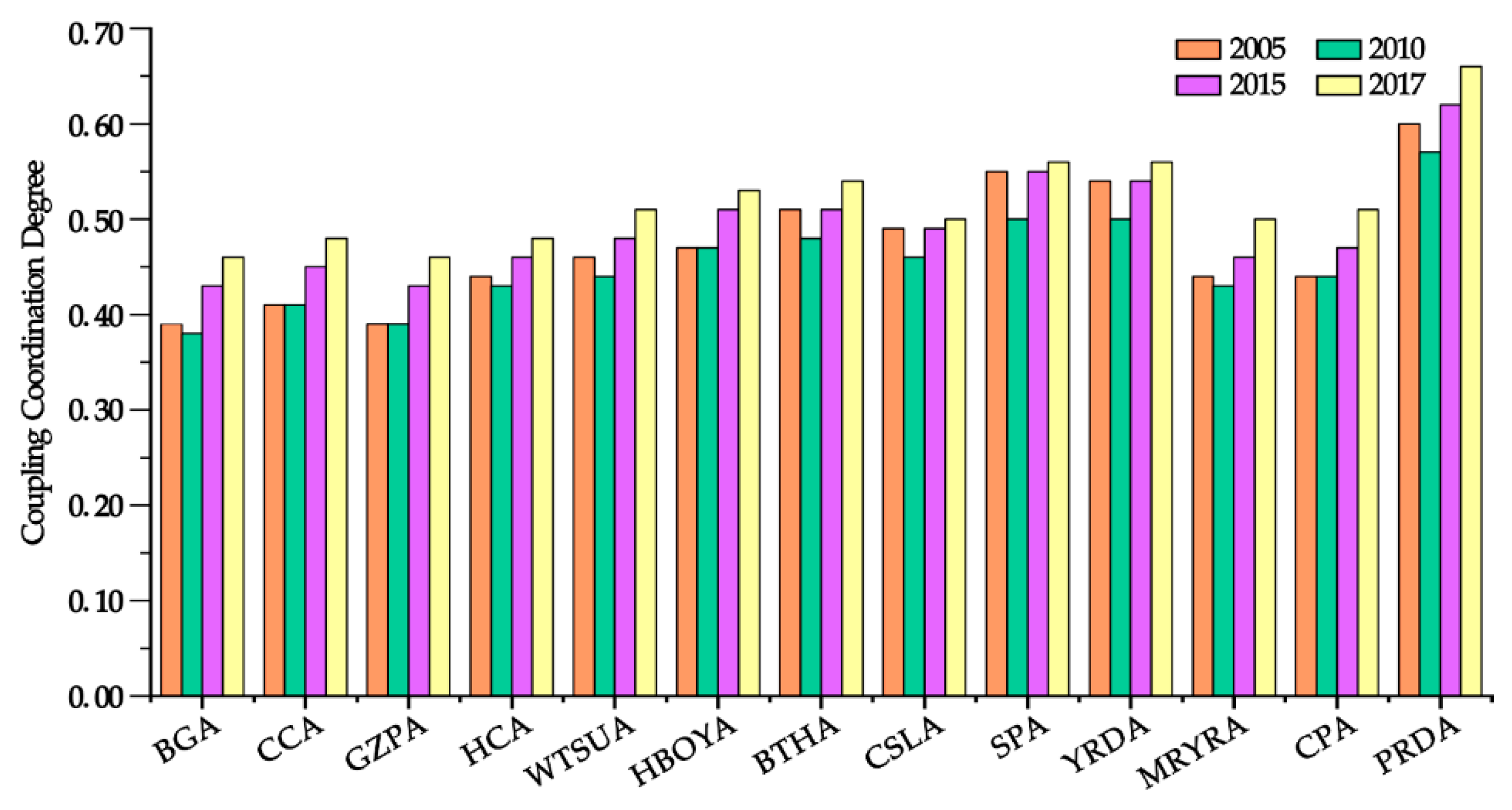
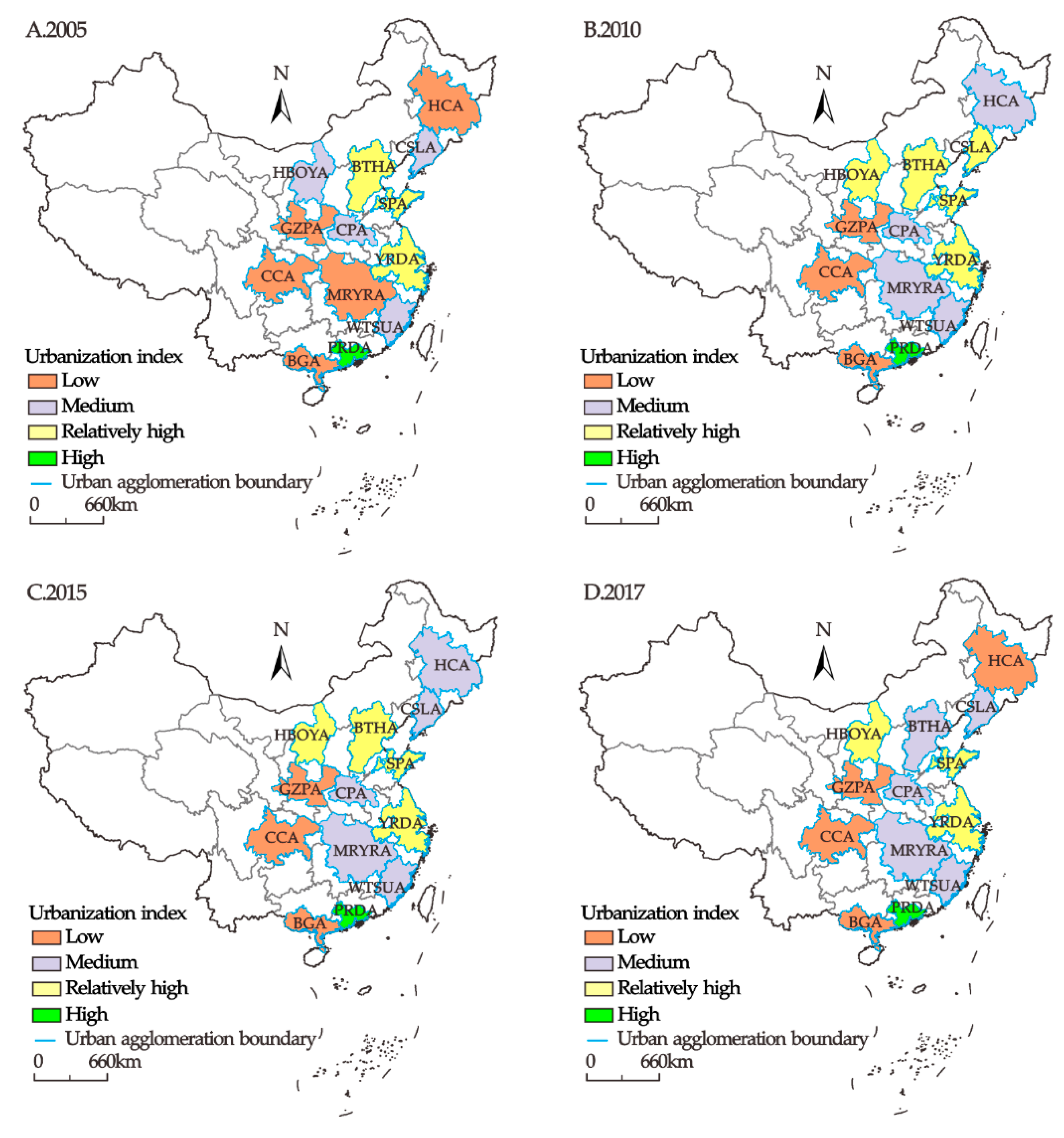
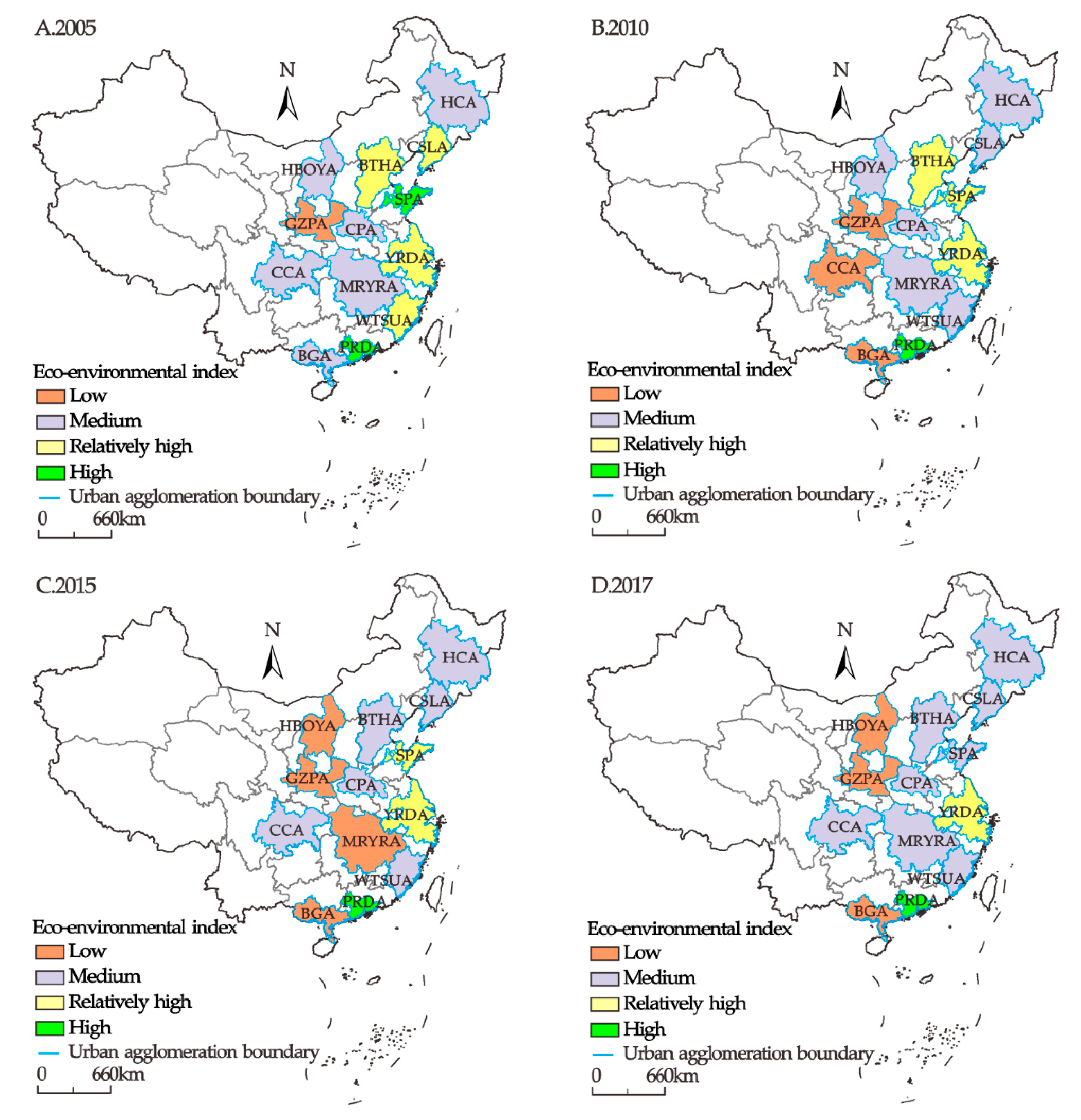
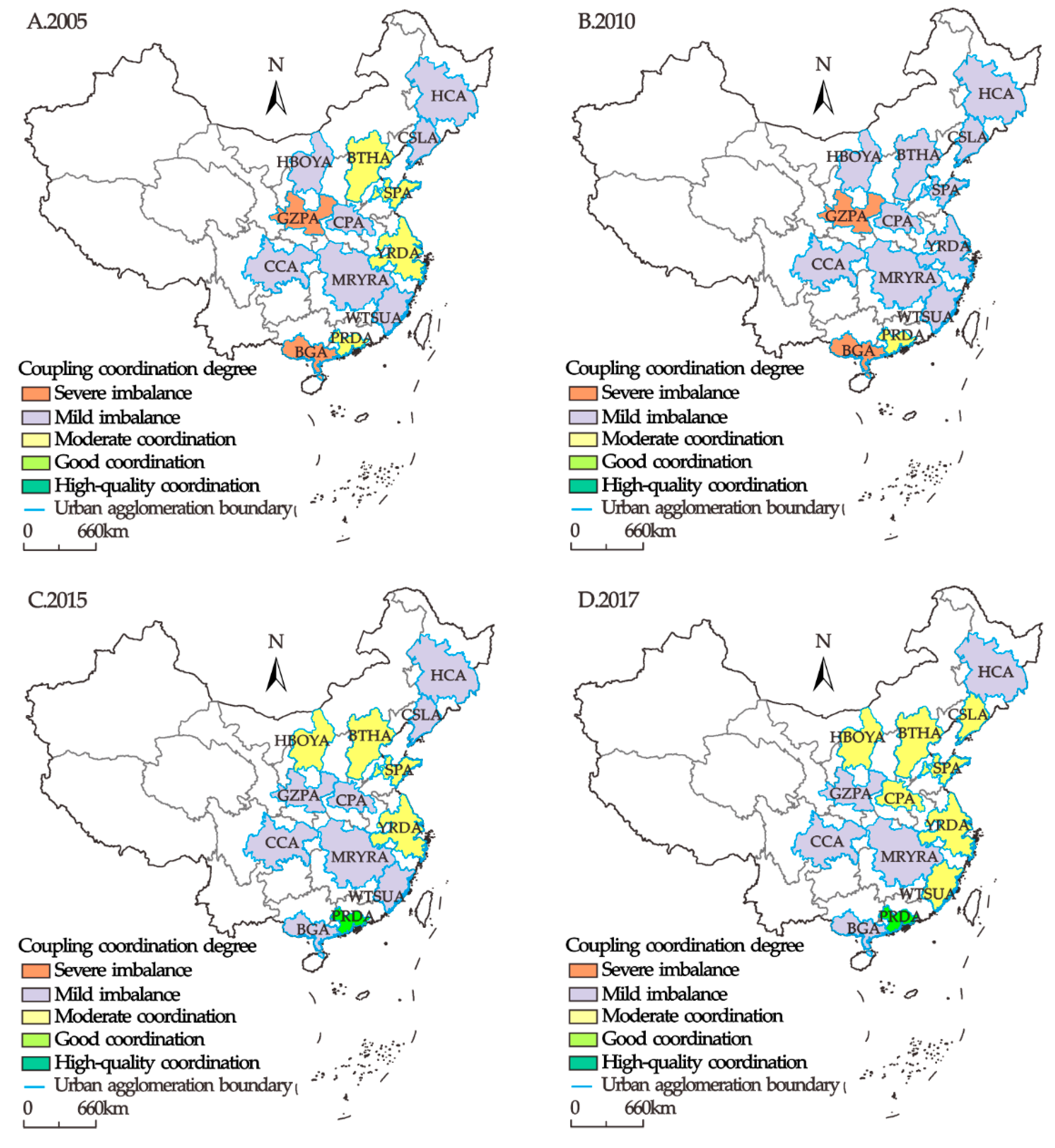
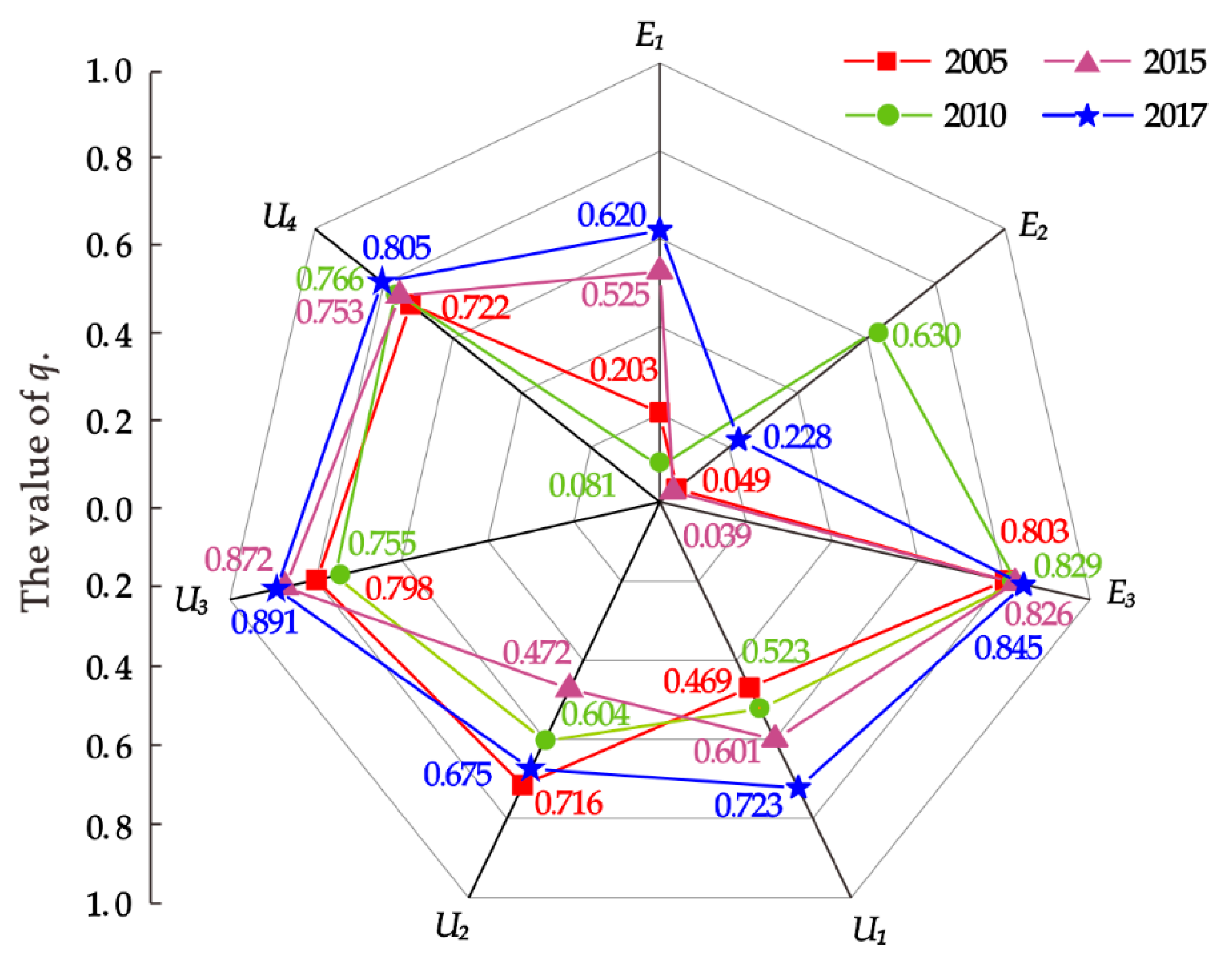
| Coupled Coordination Degree | Type |
|---|---|
| 0.8 < D ≤ 1.0 | High-quality coordination |
| 0.6 < D ≤ 0.8 | Good coordination |
| 0.5 < D ≤ 0.6 | Moderate coordination |
| 0.4 < D ≤ 0.5 | Mild imbalance |
| 0.0 < D ≤ 0.4 | Severe imbalance |
| System | Subsystem | Indicators | Attributes |
|---|---|---|---|
| Urbanization system | U1: Population urbanization | I1: Urbanization rate (%) | + |
| I2: Population density of built-up area (person/km2) | + | ||
| I3: Proportion of employees in the secondary industry (%) | + | ||
| I4: Proportion of employees in the tertiary industry (%) | + | ||
| U2: Economic urbanization | I5: Per capita GDP (Yuan) | + | |
| I6: Per capita social fixed asset investment (yuan/person) | + | ||
| I7: GDP growth rate (%) | + | ||
| I8: Proportion of the secondary industry in GDP (%) | + | ||
| I9: Proportion of the tertiary industry in GDP (%) | + | ||
| U3: Social urbanization | I10: Collection of books in public libraries per 10,000 people (books/10,000 people) | + | |
| I11: Total retail sales of consumer goods per capita (yuan/person) | + | ||
| I12: Average salary level of on-post employees (yuan) | + | ||
| I13: Number of beds per 10,000 people (bed/10,000 people) | + | ||
| I14: Number of college students per 10,000 people (person/10,000 people) | + | ||
| I15: Number of doctors per 10,000 people (person/10,000 people) | + | ||
| I16: Number of public transport per 10,000 people (vehicles/10,000 people) | + | ||
| I17: Number of internet broadband access users per 10,000 people (households/10,000 households) | + | ||
| U4: Spatial urbanization | I18: Proportion of urban construction land in urban area (%) | + | |
| I19: Road area ratio in built-up area (%) | + | ||
| I20: Highway mileage per capita (km/10,000 people) | + | ||
| I21: Traffic network density (km/km2) | + | ||
| I22: Urban construction land area per capita (km2/10,000 people) | + | ||
| Eco-environment system | E1: Eco-environmental pressure | I23: Natural population growth rate (‰) | - |
| I24: Comprehensive water consumption per capita (m3/person · year) | - | ||
| I25: Natural gas consumption per capita (m3/person · year) | - | ||
| I26: Consumption of LPG per capita (tons/10,000 people) | - | ||
| E2: Eco-environmental state | I27: Green coverage rate in built-up areas (%) | + | |
| I28: Water resources per capita (m3/person) | + | ||
| I29: Industrial waste water discharge per capita (ton/person) | - | ||
| I30: Industrial SO2 emissions per capita (tons/10,000 people) | - | ||
| I31: Emissions of industrial dust discharge per capita (tons/10,000 people) | - | ||
| E3: Eco-environmental response | I32: Harmless disposal rate of household garbage (%) | + | |
| I33: Sewage treatment rate (%) | + | ||
| I34: Comprehensive utilization rate of industrial solid waste (%) | + | ||
| I35: Expenditure on science and technology per capita (yuan) | + |
| Name | Population Urbanization | Economic Urbanization | Social Urbanization | Spatial Urbanization | ||||||||||||
|---|---|---|---|---|---|---|---|---|---|---|---|---|---|---|---|---|
| 2005 | 2010 | 2015 | 2017 | 2005 | 2010 | 2015 | 2017 | 2005 | 2010 | 2015 | 2017 | 2005 | 2010 | 2015 | 2017 | |
| BGA | 0.023 | 0.023 | 0.028 | 0.029 | 0.019 | 0.018 | 0.026 | 0.033 | 0.014 | 0.022 | 0.025 | 0.042 | 0.012 | 0.012 | 0.013 | 0.023 |
| CCA | 0.027 | 0.030 | 0.029 | 0.037 | 0.017 | 0.019 | 0.022 | 0.025 | 0.022 | 0.027 | 0.033 | 0.049 | 0.012 | 0.015 | 0.019 | 0.036 |
| GZPA | 0.021 | 0.025 | 0.023 | 0.030 | 0.025 | 0.021 | 0.026 | 0.028 | 0.022 | 0.025 | 0.029 | 0.049 | 0.009 | 0.010 | 0.012 | 0.026 |
| HCA | 0.023 | 0.023 | 0.019 | 0.024 | 0.030 | 0.030 | 0.030 | 0.037 | 0.032 | 0.043 | 0.045 | 0.060 | 0.016 | 0.016 | 0.018 | 0.027 |
| WTSUA | 0.028 | 0.034 | 0.024 | 0.041 | 0.036 | 0.031 | 0.044 | 0.048 | 0.024 | 0.031 | 0.040 | 0.053 | 0.020 | 0.021 | 0.025 | 0.048 |
| HBOYA | 0.023 | 0.025 | 0.030 | 0.031 | 0.069 | 0.071 | 0.079 | 0.094 | 0.035 | 0.045 | 0.052 | 0.080 | 0.010 | 0.017 | 0.017 | 0.026 |
| BTHA | 0.025 | 0.027 | 0.033 | 0.041 | 0.038 | 0.031 | 0.035 | 0.040 | 0.046 | 0.054 | 0.062 | 0.077 | 0.048 | 0.049 | 0.038 | 0.057 |
| CSLA | 0.029 | 0.034 | 0.030 | 0.033 | 0.047 | 0.044 | 0.039 | 0.036 | 0.034 | 0.038 | 0.042 | 0.063 | 0.027 | 0.028 | 0.030 | 0.046 |
| SPA | 0.031 | 0.035 | 0.037 | 0.044 | 0.069 | 0.053 | 0.062 | 0.074 | 0.049 | 0.056 | 0.075 | 0.081 | 0.027 | 0.033 | 0.036 | 0.065 |
| YRDA | 0.031 | 0.041 | 0.041 | 0.048 | 0.058 | 0.046 | 0.053 | 0.058 | 0.045 | 0.054 | 0.065 | 0.077 | 0.044 | 0.036 | 0.041 | 0.067 |
| MRYRA | 0.025 | 0.030 | 0.031 | 0.037 | 0.025 | 0.026 | 0.034 | 0.039 | 0.026 | 0.030 | 0.034 | 0.050 | 0.019 | 0.021 | 0.021 | 0.035 |
| CPA | 0.030 | 0.035 | 0.035 | 0.044 | 0.026 | 0.024 | 0.028 | 0.033 | 0.021 | 0.029 | 0.032 | 0.051 | 0.028 | 0.029 | 0.032 | 0.050 |
| PRDA | 0.046 | 0.048 | 0.051 | 0.058 | 0.076 | 0.068 | 0.057 | 0.072 | 0.057 | 0.085 | 0.103 | 0.117 | 0.075 | 0.068 | 0.098 | 0.147 |
| Name | Eco-Environmental Pressure | Eco-Environmental State | Eco-Environmental Response | |||||||||
|---|---|---|---|---|---|---|---|---|---|---|---|---|
| 2005 | 2010 | 2015 | 2017 | 2005 | 2010 | 2015 | 2017 | 2005 | 2010 | 2015 | 2017 | |
| BGA | 0.074 | 0.073 | 0.111 | 0.109 | 0.120 | 0.101 | 0.120 | 0.136 | 0.150 | 0.109 | 0.139 | 0.111 |
| CCA | 0.092 | 0.089 | 0.138 | 0.127 | 0.106 | 0.098 | 0.112 | 0.126 | 0.155 | 0.105 | 0.144 | 0.107 |
| GZPA | 0.092 | 0.087 | 0.130 | 0.120 | 0.108 | 0.096 | 0.109 | 0.130 | 0.115 | 0.111 | 0.136 | 0.101 |
| HCA | 0.098 | 0.087 | 0.138 | 0.140 | 0.118 | 0.097 | 0.113 | 0.125 | 0.138 | 0.126 | 0.138 | 0.096 |
| WTSUA | 0.084 | 0.082 | 0.117 | 0.106 | 0.123 | 0.100 | 0.121 | 0.138 | 0.212 | 0.140 | 0.160 | 0.123 |
| HBOYA | 0.090 | 0.083 | 0.122 | 0.125 | 0.090 | 0.087 | 0.106 | 0.123 | 0.177 | 0.146 | 0.145 | 0.084 |
| BTHA | 0.086 | 0.083 | 0.123 | 0.124 | 0.112 | 0.092 | 0.115 | 0.131 | 0.226 | 0.157 | 0.173 | 0.127 |
| CSLA | 0.102 | 0.089 | 0.140 | 0.134 | 0.119 | 0.096 | 0.120 | 0.133 | 0.199 | 0.136 | 0.145 | 0.095 |
| SPA | 0.096 | 0.087 | 0.131 | 0.111 | 0.121 | 0.097 | 0.116 | 0.128 | 0.300 | 0.158 | 0.177 | 0.129 |
| YRDA | 0.096 | 0.085 | 0.130 | 0.116 | 0.114 | 0.094 | 0.116 | 0.131 | 0.248 | 0.163 | 0.192 | 0.156 |
| MRYRA | 0.086 | 0.085 | 0.120 | 0.121 | 0.121 | 0.101 | 0.117 | 0.138 | 0.175 | 0.131 | 0.146 | 0.115 |
| CPA | 0.084 | 0.084 | 0.123 | 0.118 | 0.112 | 0.092 | 0.113 | 0.134 | 0.160 | 0.134 | 0.159 | 0.115 |
| PRDA | 0.079 | 0.069 | 0.093 | 0.079 | 0.120 | 0.109 | 0.118 | 0.132 | 0.300 | 0.225 | 0.278 | 0.258 |
Publisher’s Note: MDPI stays neutral with regard to jurisdictional claims in published maps and institutional affiliations. |
© 2020 by the authors. Licensee MDPI, Basel, Switzerland. This article is an open access article distributed under the terms and conditions of the Creative Commons Attribution (CC BY) license (http://creativecommons.org/licenses/by/4.0/).
Share and Cite
Wan, J.; Zhang, L.; Yan, J.; Wang, X.; Wang, T. Spatial–Temporal Characteristics and Influencing Factors of Coupled Coordination between Urbanization and Eco-Environment: A Case Study of 13 Urban Agglomerations in China. Sustainability 2020, 12, 8821. https://doi.org/10.3390/su12218821
Wan J, Zhang L, Yan J, Wang X, Wang T. Spatial–Temporal Characteristics and Influencing Factors of Coupled Coordination between Urbanization and Eco-Environment: A Case Study of 13 Urban Agglomerations in China. Sustainability. 2020; 12(21):8821. https://doi.org/10.3390/su12218821
Chicago/Turabian StyleWan, Jia, Liwei Zhang, Junping Yan, Xiaomeng Wang, and Ting Wang. 2020. "Spatial–Temporal Characteristics and Influencing Factors of Coupled Coordination between Urbanization and Eco-Environment: A Case Study of 13 Urban Agglomerations in China" Sustainability 12, no. 21: 8821. https://doi.org/10.3390/su12218821
APA StyleWan, J., Zhang, L., Yan, J., Wang, X., & Wang, T. (2020). Spatial–Temporal Characteristics and Influencing Factors of Coupled Coordination between Urbanization and Eco-Environment: A Case Study of 13 Urban Agglomerations in China. Sustainability, 12(21), 8821. https://doi.org/10.3390/su12218821





